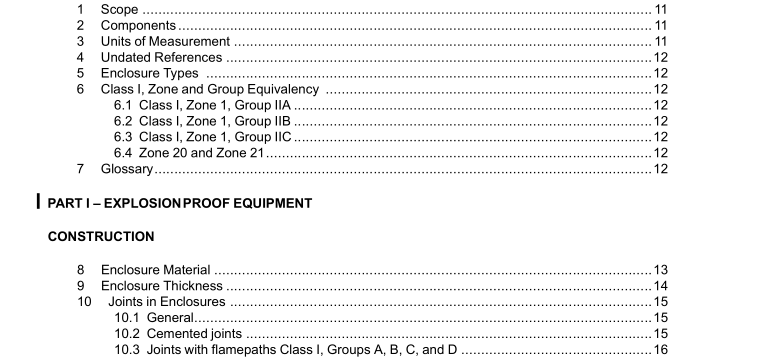UL 1203-2020 pdf download.ExplosionProof and Dust-IgnitionProof Electrical Equipment for Use in Hazardous (Classified) Locations.
35 Enclosure 35.1 General 35.1.1 The enclosure shall prevent the entrance of dust. See Dust-Penetration Test, Section 43. 35.1.2 The enclosure construction shall comply with the requirements of 35.2– 42.3 and the standards referenced in those sections. 35.1.3 The enclosure shall comply with the performance requirements of 43.1 – 57.3. 35.2 Material 35.2.1 The enclosure housing the electrical components, except those portions for viewing or light transmission, shall be made of iron, steel, copper, brass, bronze, or aluminum or aluminum alloys containing a minimum of 80 percent aluminum, or shall be made of nonmetallic material which complies with the requirements in Section 45, Polymeric Enclosure Tests. A metal such as zinc or zinc alloy, or magnesium alloy shall not be used. 35.2.2 Dust-ignition i proof electrical enclosures made of a rigid polymeric material shall have mechanical strength and durability equivalent to a comparable metal enclosure. The enclosure shall be formed so that operating parts are protected against damage, and shall resist the abuses that are encountered during installation and normal use and service and shall not accumulate static electric charges. See the Standard for Enclosures for Electrical Equipment, Non-Environmental Considerations, UL 50 and the requirements of Section 33.4. 35.2.3 When a polymeric enclosure is utilized as an insulating material in connection with a live part, the polymeric material shall be rated for the intended use as an insulator. See the Standard for Polymeric Materials – Use in Electrical Equipment Evaluations, UL 746C.
36 Joints in Enclosures 36.1 The joints in the enclosure shall be of the metal-to-metal, metal-to-glass, metal-to-polymeric, polymeric-to-polymeric, or polymeric-to-glass type. The roughness of joint surfaces shall comply with the requirement in 10.1.2. Exception: A glass part, such as a pilot light lens, is not prohibited from being sealed with a sealing compound that: a) Is resistant to moisture and aging; and b) Complies with the othertest requirements in this Standard without loosening orcracking. The length ofcompound seal shall not be less than the minimum length ofjoint required for an unsealed joint, or 5/8 inch (15.9 mm), whichever is less. The sealing compound shall not be relied upon for mechanical securityofthe joint. 36.2 A sealing material applied to a joint surface in accordance with Exception No. 2 to 42.3 shall not increase the maximum required clearance between the joint surfaces. 36.3 The width of the joint measured from the inside of the enclosure to the outside shall not be less than 3/16 inch (4.8 mm). The clearance at the joint shall not be more than 0.002 inch (0.05 mm) for a 3/16 inch wide joint and not more than 0.003 inch (0.08 mm) for a 1/4 inch (6.4 mm) wide joint. These specified widths shall be provided between the inside of the enclosure and the nearest edge of each bolt hole or other interruptions in the joint. 36.4 Threaded joints shall consist of at least three threads fully engaged. Screws shall not have more than 32 threads per inch (per 25.4 mm).
Exception No. 1: The gasket shall not be attached by an adhesive or cement unless aging tests on the construction show that the means ofattachment does not deteriorate by compliance with thermal aging in 45.2. Exception No. 2: A gasket that is secured in a joint not intended to be opened after the equipment is assembled is not required to be mechanicallyattached. 36.6 When a gasket of polytetrafluoroethylene or similar material is used, it shall be installed to reduce the risk of cold flow of the gasket material. 36.7 A material that upon aging either hardens or adheres to joint surfaces shall not be used as a gasket material. 37 Shaft Openings 37.1 A shaft opening in an enclosure shall be of the metal-to-metal type or metal-to-polymeric type. See 10.1.2 regarding the roughness of surfaces that form the shaft path. 37.2 Non-rotating shafts and shafts rotating at a speed of less than 100 rpm shall have a length of path of not less than 1/2 inch (12.7 mm). The maximum diametrical clearance between the shaft and shaft opening shall be: a) 0.005 inch (0.13 mm) for a 1/2 inch (12.7 mm) length of path; b) 0.008 inch (0.20 mm) for a 1 inch (25.4 mm) length of path; and c) 0.011 inch (0.28 mm) for a 1-1/2 inch (38.1 mm) length of path. Intermediate values are proportional. Exception No. 1: An opening for a shaft that is centered in the opening by bearings or an equivalent construction that prevents contact between the shaft and the shaft opening is not required to comply with these requirements when it complies with the requirements in 37.3 – 37.5.UL 1203-2020 pdf download.
UL 1203-2020 pdf download
